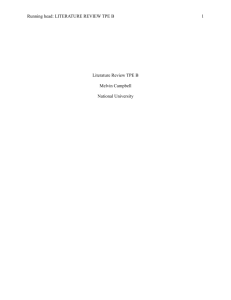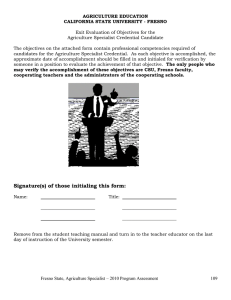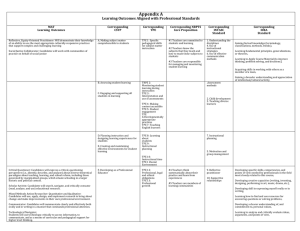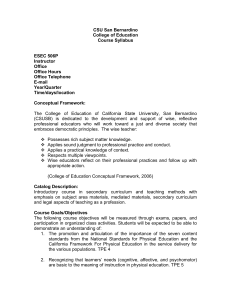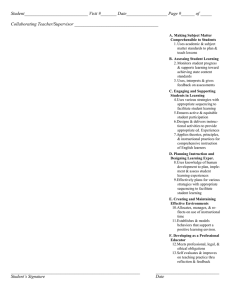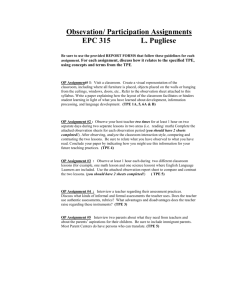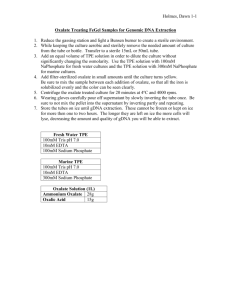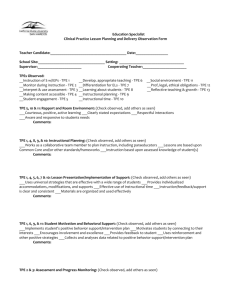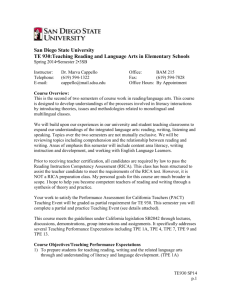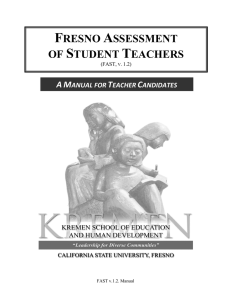TPE Summary
advertisement
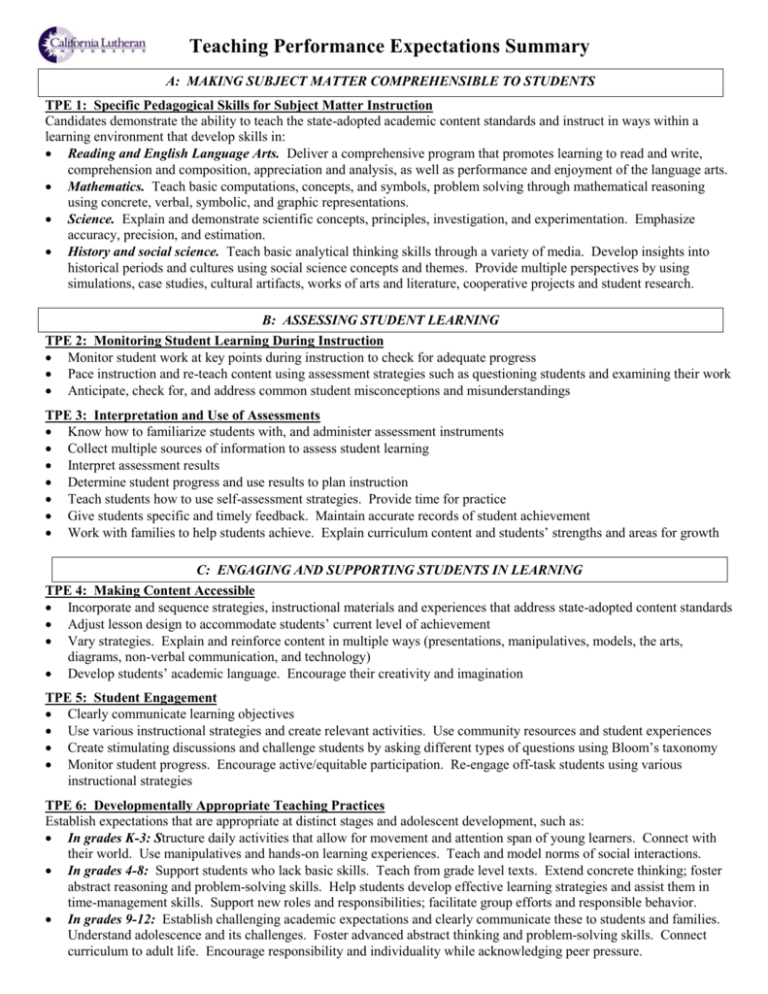
Teaching Performance Expectations Summary A: MAKING SUBJECT MATTER COMPREHENSIBLE TO STUDENTS TPE 1: Specific Pedagogical Skills for Subject Matter Instruction Candidates demonstrate the ability to teach the state-adopted academic content standards and instruct in ways within a learning environment that develop skills in: Reading and English Language Arts. Deliver a comprehensive program that promotes learning to read and write, comprehension and composition, appreciation and analysis, as well as performance and enjoyment of the language arts. Mathematics. Teach basic computations, concepts, and symbols, problem solving through mathematical reasoning using concrete, verbal, symbolic, and graphic representations. Science. Explain and demonstrate scientific concepts, principles, investigation, and experimentation. Emphasize accuracy, precision, and estimation. History and social science. Teach basic analytical thinking skills through a variety of media. Develop insights into historical periods and cultures using social science concepts and themes. Provide multiple perspectives by using simulations, case studies, cultural artifacts, works of arts and literature, cooperative projects and student research. B: ASSESSING STUDENT LEARNING TPE 2: Monitoring Student Learning During Instruction Monitor student work at key points during instruction to check for adequate progress Pace instruction and re-teach content using assessment strategies such as questioning students and examining their work Anticipate, check for, and address common student misconceptions and misunderstandings TPE 3: Interpretation and Use of Assessments Know how to familiarize students with, and administer assessment instruments Collect multiple sources of information to assess student learning Interpret assessment results Determine student progress and use results to plan instruction Teach students how to use self-assessment strategies. Provide time for practice Give students specific and timely feedback. Maintain accurate records of student achievement Work with families to help students achieve. Explain curriculum content and students’ strengths and areas for growth C: ENGAGING AND SUPPORTING STUDENTS IN LEARNING TPE 4: Making Content Accessible Incorporate and sequence strategies, instructional materials and experiences that address state-adopted content standards Adjust lesson design to accommodate students’ current level of achievement Vary strategies. Explain and reinforce content in multiple ways (presentations, manipulatives, models, the arts, diagrams, non-verbal communication, and technology) Develop students’ academic language. Encourage their creativity and imagination TPE 5: Student Engagement Clearly communicate learning objectives Use various instructional strategies and create relevant activities. Use community resources and student experiences Create stimulating discussions and challenge students by asking different types of questions using Bloom’s taxonomy Monitor student progress. Encourage active/equitable participation. Re-engage off-task students using various instructional strategies TPE 6: Developmentally Appropriate Teaching Practices Establish expectations that are appropriate at distinct stages and adolescent development, such as: In grades K-3: Structure daily activities that allow for movement and attention span of young learners. Connect with their world. Use manipulatives and hands-on learning experiences. Teach and model norms of social interactions. In grades 4-8: Support students who lack basic skills. Teach from grade level texts. Extend concrete thinking; foster abstract reasoning and problem-solving skills. Help students develop effective learning strategies and assist them in time-management skills. Support new roles and responsibilities; facilitate group efforts and responsible behavior. In grades 9-12: Establish challenging academic expectations and clearly communicate these to students and families. Understand adolescence and its challenges. Foster advanced abstract thinking and problem-solving skills. Connect curriculum to adult life. Encourage responsibility and individuality while acknowledging peer pressure. TPE 7: Teaching English Learners Know and use effective ELD strategies leading to English literacy Differentiate instruction and select appropriate instructional materials and strategies based on individual language assessment data Collaborate with specialists and para-educators Develop students’ academic knowledge and language in core subjects Use effective questioning strategies and model English constructions D: PLANNING INSTRUCTION AND DESIGNING LEARNING EXPERIENCES FOR STUDENTS TPE 8: Learning about Students Use knowledge of patterns of child and adolescent development to understand students Assess students’ language abilities, content knowledge and skill, using both formal methods and interpersonal interactions Encourage, support and facilitate parent participation Understand how factors such as gender and health influence behavior and learning potential Use multiple means of assessment to identify students with special needs TPE 9: Instructional Planning Plan comprehensive instruction based on state-adopted academic content standards Establish short and long term learning goals based on state and local standards as well as student current achievement levels Use a variety of explicit teaching methods Use experience and reflection to improve implementation of instructional strategies Sequence instruction appropriately, using effective strategies and instructional material Connect academic content with students’ backgrounds, interests, and needs Differentiate instruction to accommodate students’ needs Use support personnel to help students reach goals E: CREATING AND MAINTAINING EFFECTIVE ENVIRONMENTS FOR STUDENT LEARNING TPE 10: Instructional Time Allocate instructional time to maximize student achievement Establish procedures for routine tasks and manage transitions efficiently Use reflection and consultation to adjust instructional time to optimize learning opportunities and outcomes TPE 11: Social Environment Develop and maintain clear academic and behavioral expectations, effectively implementing a discipline plan Create a positive climate for learning by promoting student effort and engagement Establish rapport with students and their families through caring, respect, fairness and sensitivity Foster responsibility and independence in students Make necessary changes in the social environment to maximize academic achievement F: DEVELOPING AS A PROFESSIONAL EDUCATOR TPE 12: Professional, legal and ethical obligations Take responsibility for student academic learning outcomes, ensuring that they are met Resist racism and acts of intolerance and maintain a non-hostile classroom environment Understand and implement state and federal law and school and district policies Understand and honor professional and legal obligations and model ethical behaviors TPE 13: Professional Growth Evaluate their own teaching practices and subject matter knowledge and solicit feedback Improve their teaching practices by using reflection and feedback to formulate and prioritize goals
